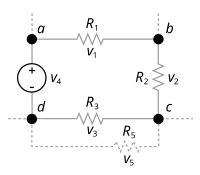 |  |
|
#1
| ||||
| ||||
| Asslam-o-Aliqum ! Kirchhoff's circuit laws Kirchhoff's circuit laws are two equalities that deal with the conservation of charge and energy in electrical circuits, and were first described in 1845 by Gustav Kirchhoff. Widely used in electrical engineering, they are also called Kirchhoff's rules or simply Kirchhoff's laws (see also Kirchhoff's laws for other meanings of that term). Both circuit rules can be directly derived from Maxwell's equations, but Kirchhoff preceded Maxwell and instead generalized work by Georg Ohm. Kirchhoff's voltage law (KVL)   The sum of all the voltages around the loop is equal to zero. v1 + v2 + v3 - v4 = 0 This law is also called Kirchhoff's second law, Kirchhoff's loop (or mesh) rule, and Kirchhoff's second rule. The principle of conservation of energy implies that The directed sum of the electrical potential differences (voltage) around any closed circuit is zero. or More simply, the sum of the emfs in any closed loop is equivalent to the sum of the potential drops in that loop. or The algebraic sum of the products of the resistances of the conductors and the currents in them in a closed loop is equal to the total emf available in that loop. Similarly to KCL, it can be stated as:  Here, n is the total number of voltages measured. The voltages may also be complex: Here, n is the total number of voltages measured. The voltages may also be complex: This law is based on the conservation of "energy given/taken by potential field" (not including energy taken by dissipation). Given a voltage potential, a charge which has completed a closed loop doesn't gain or lose energy as it has gone back to initial potential level. This law is based on the conservation of "energy given/taken by potential field" (not including energy taken by dissipation). Given a voltage potential, a charge which has completed a closed loop doesn't gain or lose energy as it has gone back to initial potential level.This law holds true even when resistance (which causes dissipation of energy) is present in a circuit. The validity of this law in this case can be understood if one realizes that a charge in fact doesn't go back to its starting point, due to dissipation of energy. A charge will just terminate at the negative terminal, instead of positive terminal. This means all the energy given by the potential difference has been fully consumed by resistance which in turn loses the energy as heat dissipation. To summarize, Kirchhoff's voltage law has nothing to do with gain or loss of energy by electronic components (resistors, capacitors, etc.). It is a law referring to the potential field generated by voltage sources. In this potential field, regardless of what electronic components are present, the gain or loss in "energy given by the potential field" must be zero when a charge completes a closed loop. Electric field and electric potential Kirchhoff's voltage law could be viewed as a consequence of the principle of conservation of energy. Otherwise, it would be possible to build a perpetual motion machine that passed a current in a circle around the circuit. Considering that electric potential is defined as a line integral over an electric field, Kirchhoff's voltage law can be expressed equivalently as  which states that the line integral of the electric field around closed loop C is zero. which states that the line integral of the electric field around closed loop C is zero.In order to return to the more special form, this integral can be "cut in pieces" in order to get the voltage at specific components. This is a simplification of Faraday's law of induction for the special case where there is no fluctuating magnetic field linking the closed loop. Therefore, it practically suffices for explaining circuits containing only resistors and capacitors. In the presence of a changing magnetic field the electric field is not conservative and it cannot therefore define a pure scalar potential—the line integral of the electric field around the circuit is not zero. This is because energy is being transferred from the magnetic field to the current (or vice versa). In order to "fix" Kirchhoff's voltage law for circuits containing inductors, an effective potential drop, or electromotive force (emf), is associated with each inductance of the circuit, exactly equal to the amount by which the line integral of the electric field is not zero by Faraday's law of induction.
__________________  |
 |
| Tags |
| kirchhoff, kvl, law, voltage |
« Previous Thread
|
Next Thread »
| Currently Active Users Viewing This Thread: 1 (0 members and 1 guests) | |
| |
 Similar Threads
Similar Threads | ||||
| Thread | Thread Starter | Forum | Replies | Last Post |
| Kirchhoff's current law (KCL) | bonfire | Electrical Circuits | 0 | 17-04-2011 12:13 AM |
| Chapter 15: Power Supplies (Voltage Regulators) | bonfire | Electrical Circuits | 0 | 19-03-2011 08:11 PM |
| High Voltage Electrical Wire Fire - Northfield, MN | usman_latif_ch | Youtube Videos/Clips etc | 0 | 12-12-2009 08:04 PM |
| Kirchoff's Current & Voltage Law:who know how to solve the problems mathematically | .BZU. | Quotes | 1 | 28-01-2009 11:49 PM |
| Voltage and Current Sources | .BZU. | Electromagnetism | 0 | 05-09-2008 02:59 AM |
Almuslimeen.info | BZU Multan | Dedicated server hosting
Note: All trademarks and copyrights held by respective owners. We will take action against any copyright violation if it is proved to us.
All times are GMT +5. The time now is 04:16 AM.
Powered by vBulletin® Version 3.8.2
Copyright ©2000 - 2024, Jelsoft Enterprises Ltd.
Copyright ©2000 - 2024, Jelsoft Enterprises Ltd.



 bonfire
bonfire







 Linear Mode
Linear Mode

